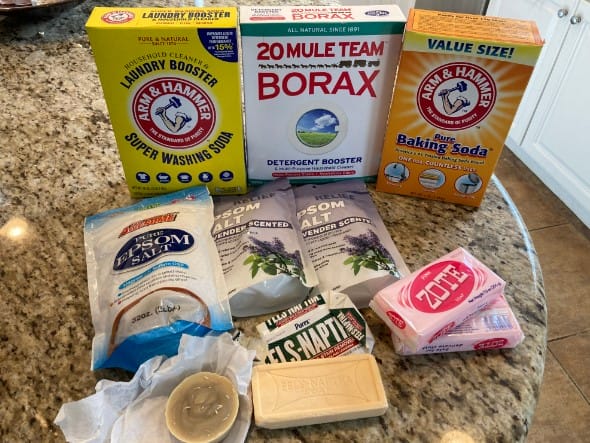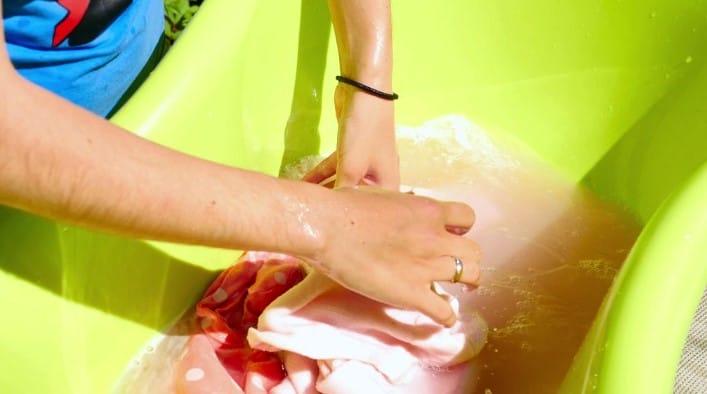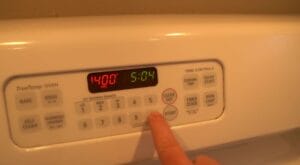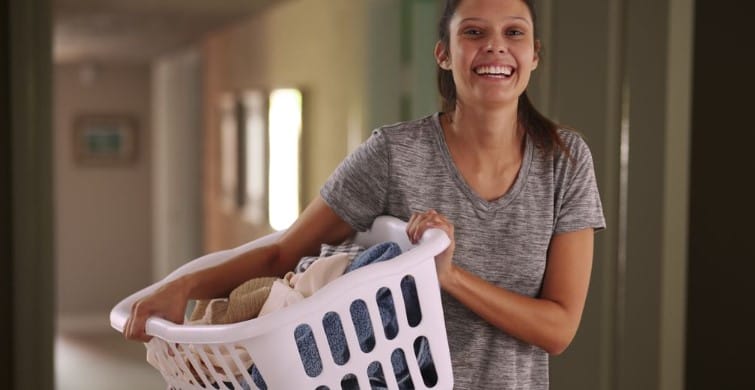 There’s a debate and controversy on the internet about how effective DIY laundry detergent actually is at getting clothes clean. People are passionate about their laundry detergents. Research any one ingredient of any laundry detergent and you will find its great use and its harmful effect. When we set out to make my recipe we favored natural ingredients that could do the job well with minimal impact on the environment. As with any highly concentrated substance, it’s toxic for human consumption, just like all laundry detergent, so keep it away from kids and pets.
Detergent residue, fabric softeners, minerals from hard water, and body oils can all build up in textiles over time. This has led to a recent craze called laundry stripping where clothing is soaked in a mix of Borax and water. Clean laundry leaves behind brown murky water, which is the accumulation of all those nasties we mentioned a moment ago. To try this you just need to put some towels you swear are clean in a hot tub of water with a 1/4 cup of borax, a 1/4 cup of washing soda, and a 1/4 cup of laundry detergent. While it is “stripping” your laundry and giving it a deep cleanse of any accumulated detergents, dirt, fabric softeners, hard minerals, and oils, it is also acting on the dyes at that harsh ratio and strength. That’s what is really causing the dirty-looking water. So, yes it’s working, but no it isn’t working to the extent that it might visually appear to be working. We like to think of laundry stripping as turning to the old ways to strip away the accumulations left by the new ways because we think some detergents actually stick to the fabrics of your clothes and attract dirt. You can use 1/4 cup of this detergent recipe in a bath of hot water to perform laundry stripping. Then put those stripped textiles in a rinse-only cycle in your washing machine along with 1/4 cup white distilled vinegar. Your laundry will be amazingly clean.
Fortunately for us, this recipe uses borax, baking soda, washing soda, and detergent bars, so it is already acting at much smaller doses to soften the water, strip away dirt and grime, but not at a level that’s harsh on your clothes. When using soaps of any kind, you will have build-ups, and this is where a lot of cautions come in, especially with high-efficiency washers. Any soap buildup in a high-efficiency washer can cause a host of problems. Even with HE-specific commercial detergents, though, you will still see soap and detergent buildup. This is why our formulation has Epsom salts (magnesium sulfate) in it, and also why you should always use 1/4 cup white distilled vinegar as a fabric softener. This will clean your clothes further and soften them in a way far superior to commercial fabric softeners and with none of the chemicals that do who knows what to our bodies.
For this recipe, you will need 3 lbs. Arm & Hammer Super Washing Soda, 4 lbs. Borax, 4 lbs. Baking Soda, 2lbs. Epsom salt, and 3-4 bars of Zote or Fels-Naptha laundry soap. Here we are using 2 bars of Zote, a leftover Fels-Naptha bar from my earlier video on doing laundry after a grid-down situation, and a 2-ounce bar of my homemade soap also from an earlier blog. You can skip the homemade addition if you didn’t make a batch of your own soap. The Zote has a laundry detergent scent whereas the Fels-Naptha has much less of a scent. The Zote has citronella in it, which is why it has that smell. If you are sensitive to scents or you want to use essential oils for your scent, use Fels-Naptha instead of Zote and use the oils in with your vinegar fabric softener so they retain their scent. We got most of these ingredients at the dollar store or my local savings market, and all of them for less than a total of twenty dollars. Laundry detergent and laundry soap are too harsh for regular skin. It’s the saponification of the soap that has rendered it perfectly harsh enough to clean clothes but too harsh for direct skin washing.
The super washing soda and baking soda act as boosters and fresheners. They also help to eliminate odors. Washing soda is sodium carbonate. It has a high pH of 11 which makes it pretty alkaline. If you can’t find it in the stores you can make it out of baking soda by heating the baking soda on a cookie sheet at 400 degrees for a half-hour. This will liberate from the baking soda the hydrogen atom. You basically convert NaHCO3 to Na2C03. Our recipe uses both Super Washing Soda and Baking Soda. Epsom salts typically come scented and unscented. You can always use about 15 drops of essential oil in this recipe to add scent. For my purposes, we will use 2 pounds of lavender-scented Epsom salts. That will probably all get washed out in the main wash. The Epsom salts are magnesium sulfate. They will also boost your laundry and act as a fabric softener.
MAKING THE DETERGENT
There’s a debate and controversy on the internet about how effective DIY laundry detergent actually is at getting clothes clean. People are passionate about their laundry detergents. Research any one ingredient of any laundry detergent and you will find its great use and its harmful effect. When we set out to make my recipe we favored natural ingredients that could do the job well with minimal impact on the environment. As with any highly concentrated substance, it’s toxic for human consumption, just like all laundry detergent, so keep it away from kids and pets.
Detergent residue, fabric softeners, minerals from hard water, and body oils can all build up in textiles over time. This has led to a recent craze called laundry stripping where clothing is soaked in a mix of Borax and water. Clean laundry leaves behind brown murky water, which is the accumulation of all those nasties we mentioned a moment ago. To try this you just need to put some towels you swear are clean in a hot tub of water with a 1/4 cup of borax, a 1/4 cup of washing soda, and a 1/4 cup of laundry detergent. While it is “stripping” your laundry and giving it a deep cleanse of any accumulated detergents, dirt, fabric softeners, hard minerals, and oils, it is also acting on the dyes at that harsh ratio and strength. That’s what is really causing the dirty-looking water. So, yes it’s working, but no it isn’t working to the extent that it might visually appear to be working. We like to think of laundry stripping as turning to the old ways to strip away the accumulations left by the new ways because we think some detergents actually stick to the fabrics of your clothes and attract dirt. You can use 1/4 cup of this detergent recipe in a bath of hot water to perform laundry stripping. Then put those stripped textiles in a rinse-only cycle in your washing machine along with 1/4 cup white distilled vinegar. Your laundry will be amazingly clean.
Fortunately for us, this recipe uses borax, baking soda, washing soda, and detergent bars, so it is already acting at much smaller doses to soften the water, strip away dirt and grime, but not at a level that’s harsh on your clothes. When using soaps of any kind, you will have build-ups, and this is where a lot of cautions come in, especially with high-efficiency washers. Any soap buildup in a high-efficiency washer can cause a host of problems. Even with HE-specific commercial detergents, though, you will still see soap and detergent buildup. This is why our formulation has Epsom salts (magnesium sulfate) in it, and also why you should always use 1/4 cup white distilled vinegar as a fabric softener. This will clean your clothes further and soften them in a way far superior to commercial fabric softeners and with none of the chemicals that do who knows what to our bodies.
For this recipe, you will need 3 lbs. Arm & Hammer Super Washing Soda, 4 lbs. Borax, 4 lbs. Baking Soda, 2lbs. Epsom salt, and 3-4 bars of Zote or Fels-Naptha laundry soap. Here we are using 2 bars of Zote, a leftover Fels-Naptha bar from my earlier video on doing laundry after a grid-down situation, and a 2-ounce bar of my homemade soap also from an earlier blog. You can skip the homemade addition if you didn’t make a batch of your own soap. The Zote has a laundry detergent scent whereas the Fels-Naptha has much less of a scent. The Zote has citronella in it, which is why it has that smell. If you are sensitive to scents or you want to use essential oils for your scent, use Fels-Naptha instead of Zote and use the oils in with your vinegar fabric softener so they retain their scent. We got most of these ingredients at the dollar store or my local savings market, and all of them for less than a total of twenty dollars. Laundry detergent and laundry soap are too harsh for regular skin. It’s the saponification of the soap that has rendered it perfectly harsh enough to clean clothes but too harsh for direct skin washing.
The super washing soda and baking soda act as boosters and fresheners. They also help to eliminate odors. Washing soda is sodium carbonate. It has a high pH of 11 which makes it pretty alkaline. If you can’t find it in the stores you can make it out of baking soda by heating the baking soda on a cookie sheet at 400 degrees for a half-hour. This will liberate from the baking soda the hydrogen atom. You basically convert NaHCO3 to Na2C03. Our recipe uses both Super Washing Soda and Baking Soda. Epsom salts typically come scented and unscented. You can always use about 15 drops of essential oil in this recipe to add scent. For my purposes, we will use 2 pounds of lavender-scented Epsom salts. That will probably all get washed out in the main wash. The Epsom salts are magnesium sulfate. They will also boost your laundry and act as a fabric softener.
MAKING THE DETERGENT
 The first thing you must do is grind or grate the soap bars down. You can use a cheese grater for this. We don’t want to spend that kind of time on it, though, so we will cut the bars and add them into a blender or food processor along with some of the Epsom salts and baking soda to keep it dry and keep it from clumping. We will be honest, the way we learned to do this and did it in the past was by grating the bars with a semi-fine cheese grater. We think that method is still the best. Even with the additional baking soda and Epsom salt, these laundry bars contain moisture to keep them playable and soft. That puts a real strain on a blender. A food processor may be better, but moving forward we will go back to the cheese grater method. We pulsed and blended this to a pretty fine powder. We put these ingredients into a 5-gallon bucket. We continue to pulse the Epsom salts into fine dust. The smaller the particles the easier they will break down and dissolve in my laundry water.
Once all the Epsom salts and bars are ground down and placed in the bucket, 3 pounds of Super Washing Soda, and any of the remaining baking soda. You can mix and break up large particles by hand with these ingredients. When we add the 4 pounds of Borax, however, we switch to a utensil as the caustic nature of the detergent is higher. Mix these ingredients but be aware that they are slightly caustic. You may want to wear eye protection and one of those masks you have in abundance after the pandemic. It’s not really gassing off, but the fine powder isn’t good for you to inhale. Once it is mixed, you can transfer it to a nicer container, and you are good to go.
USING THE DETERGENT
The first thing you must do is grind or grate the soap bars down. You can use a cheese grater for this. We don’t want to spend that kind of time on it, though, so we will cut the bars and add them into a blender or food processor along with some of the Epsom salts and baking soda to keep it dry and keep it from clumping. We will be honest, the way we learned to do this and did it in the past was by grating the bars with a semi-fine cheese grater. We think that method is still the best. Even with the additional baking soda and Epsom salt, these laundry bars contain moisture to keep them playable and soft. That puts a real strain on a blender. A food processor may be better, but moving forward we will go back to the cheese grater method. We pulsed and blended this to a pretty fine powder. We put these ingredients into a 5-gallon bucket. We continue to pulse the Epsom salts into fine dust. The smaller the particles the easier they will break down and dissolve in my laundry water.
Once all the Epsom salts and bars are ground down and placed in the bucket, 3 pounds of Super Washing Soda, and any of the remaining baking soda. You can mix and break up large particles by hand with these ingredients. When we add the 4 pounds of Borax, however, we switch to a utensil as the caustic nature of the detergent is higher. Mix these ingredients but be aware that they are slightly caustic. You may want to wear eye protection and one of those masks you have in abundance after the pandemic. It’s not really gassing off, but the fine powder isn’t good for you to inhale. Once it is mixed, you can transfer it to a nicer container, and you are good to go.
USING THE DETERGENT
 For a typical load, you use two tablespoons of detergent in your washing machine’s detergent receptacle. That’s going to be approximately 1 ounce, or a shot glass full. For a heavily soiled load of laundry, you can increase this to two 3 tablespoons. In your fabric softener receptacle, you want to use 1/4 cup vinegar. Be careful when you pour your ingredients into their respective slots, as baking soda and vinegar cause a reaction. You should always use vinegar, however, with this detergent. When combined as we prescribe here, you prevent any buildup and maximize the cleaning factor of your detergent and softeners. You can add essential oils into the vinegar to impart a little scent to your laundry, but you don’t have to worry about your clothes coming out smelling of vinegar or you smelling like a pickle. The distilled white vinegar will not impart any vinegar smell to your clothes whatsoever. It will make them super-soft and allegedly will result in less static cling. It’s an amazing addition.
Distilled vinegar will also keep your machine performing optimally and super clean. Do not skip the vinegar step. One of the whole arguments about using commercial versus homemade detergents centers around the use of soap versus surfactants. Laundry bars are soap that has gone through the saponification process. Surfactants are typically artificial and are made to decrease water tension. For our purposes, the addition of the magnesium sulfate, the soda compounds, and the borax are all softening the water and enhancing the effect of the saponified laundry bars. Vinegar is the final step for maximizing your results. We have seen where people make a vinegar and hair conditioner combo and call it fabric softener. We do not suggest doing this. The addition of hair conditioners introduces oils that can bond to dirt, bacteria, and minerals and will result in less clean and coated clothes with long-term use. Trust me, just use the straight vinegar with maybe a few drops of essential oil in it.
You can use the same amount, 2 to 3 tablespoons, for hand washing your laundry, and your detergent used in this concentration is gentler on the environment than almost anything you can buy at the store. There are many plant additions you could put in a detergent formulation that contains either surfactants or saponins. These act on dirt and oils differently. For our purposes, we left them out, as not everyone has soap nuts, soapwort, or other plants containing saponins available to them. This basic formula should get you through just fine, and we think you will be pleased with the results, especially if you haven’t before been putting much thought into your laundry detergent. After a few weeks, you will notice cleaner clothes and possibly even feel a bit healthier when you free your environment just slightly more of potentially harmful synthetic chemicals.
HOW MANY LOADS?
For a typical load, you use two tablespoons of detergent in your washing machine’s detergent receptacle. That’s going to be approximately 1 ounce, or a shot glass full. For a heavily soiled load of laundry, you can increase this to two 3 tablespoons. In your fabric softener receptacle, you want to use 1/4 cup vinegar. Be careful when you pour your ingredients into their respective slots, as baking soda and vinegar cause a reaction. You should always use vinegar, however, with this detergent. When combined as we prescribe here, you prevent any buildup and maximize the cleaning factor of your detergent and softeners. You can add essential oils into the vinegar to impart a little scent to your laundry, but you don’t have to worry about your clothes coming out smelling of vinegar or you smelling like a pickle. The distilled white vinegar will not impart any vinegar smell to your clothes whatsoever. It will make them super-soft and allegedly will result in less static cling. It’s an amazing addition.
Distilled vinegar will also keep your machine performing optimally and super clean. Do not skip the vinegar step. One of the whole arguments about using commercial versus homemade detergents centers around the use of soap versus surfactants. Laundry bars are soap that has gone through the saponification process. Surfactants are typically artificial and are made to decrease water tension. For our purposes, the addition of the magnesium sulfate, the soda compounds, and the borax are all softening the water and enhancing the effect of the saponified laundry bars. Vinegar is the final step for maximizing your results. We have seen where people make a vinegar and hair conditioner combo and call it fabric softener. We do not suggest doing this. The addition of hair conditioners introduces oils that can bond to dirt, bacteria, and minerals and will result in less clean and coated clothes with long-term use. Trust me, just use the straight vinegar with maybe a few drops of essential oil in it.
You can use the same amount, 2 to 3 tablespoons, for hand washing your laundry, and your detergent used in this concentration is gentler on the environment than almost anything you can buy at the store. There are many plant additions you could put in a detergent formulation that contains either surfactants or saponins. These act on dirt and oils differently. For our purposes, we left them out, as not everyone has soap nuts, soapwort, or other plants containing saponins available to them. This basic formula should get you through just fine, and we think you will be pleased with the results, especially if you haven’t before been putting much thought into your laundry detergent. After a few weeks, you will notice cleaner clothes and possibly even feel a bit healthier when you free your environment just slightly more of potentially harmful synthetic chemicals.
HOW MANY LOADS?
 So, we don’t know how much laundry you do in a year. We just know it seems like we do a ton or more laundry every year. At the one tablespoon or half-ounce rate of usage, you will be able to do approximately 334 loads of laundry for an investment of under twenty dollars. That’s about 6 cents per load and nearly a load every single day of the year. According to one statistic, we came across the average American family washes 300 loads of laundry each year. Personally, we think that’s a pretty low number. In comparison to our batch and a box or bottle of detergent at the store, you will get between 20 and 100 loads of laundry from a typically sized box or bottle of commercial laundry soap. Ours is a savings of at least half to two-thirds of the money or more. The real benefit, though, in my opinion, is that this formula uses mostly all-natural ingredients and not a bunch of questionable chemicals that could be causing us harm by seeping into our skin or gassing off into our environment. You can make a double or triple batch and seal it in a 5-gallon pale to keep you in laundry detergent long after the manufacturers experience any shortages or deliveries to your store stop.
Give it a try and tell me what you think of our mix in the comments below. Is there anything you would add or take out? Have you used a similar mix or vinegar in the fabric softening phase of your wash cycle? Let us know in the comments below. We try to read many of the comments and respond to them when we can, and that’s typically within the first hour of releasing a video. Please consider subscribing to the channel if you’d like to be notified when we release a video and give this blog a thumb-up to help the channel grow.
As always, stay safe out there.
So, we don’t know how much laundry you do in a year. We just know it seems like we do a ton or more laundry every year. At the one tablespoon or half-ounce rate of usage, you will be able to do approximately 334 loads of laundry for an investment of under twenty dollars. That’s about 6 cents per load and nearly a load every single day of the year. According to one statistic, we came across the average American family washes 300 loads of laundry each year. Personally, we think that’s a pretty low number. In comparison to our batch and a box or bottle of detergent at the store, you will get between 20 and 100 loads of laundry from a typically sized box or bottle of commercial laundry soap. Ours is a savings of at least half to two-thirds of the money or more. The real benefit, though, in my opinion, is that this formula uses mostly all-natural ingredients and not a bunch of questionable chemicals that could be causing us harm by seeping into our skin or gassing off into our environment. You can make a double or triple batch and seal it in a 5-gallon pale to keep you in laundry detergent long after the manufacturers experience any shortages or deliveries to your store stop.
Give it a try and tell me what you think of our mix in the comments below. Is there anything you would add or take out? Have you used a similar mix or vinegar in the fabric softening phase of your wash cycle? Let us know in the comments below. We try to read many of the comments and respond to them when we can, and that’s typically within the first hour of releasing a video. Please consider subscribing to the channel if you’d like to be notified when we release a video and give this blog a thumb-up to help the channel grow.
As always, stay safe out there. 
